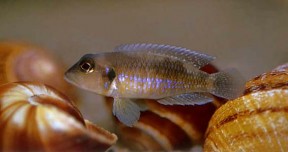Lamprologus ocellatus
Ocellated Shell-dweller
Classification
Cichlidae. Subfamily: Pseudocrenilabrinae
Distribution
Endemic to Lake Tanganyika.
Habitat
It is found in areas with scattered rocks and areas of open sand around the shoreline of the lake, in areas where the substrate is littered with empty snail shells.
Maximum Standard Length
Males to 2.4″ (6cm), females to 1.4″ (3.5cm).
Aquarium SizeTop ↑
18″ x 12″ x 12″ (45cm x 30cm x 30cm) – 40 litres for a pair or a single male and two or three females.. A larger tank is required for a colony.
Maintenance
The setup should have open areas of sandy substrate to which should be added a good number of empty snail shells (see breeding section below). More shells should be provided than there are individual fish. The substrate should be at least 2″ deep as this species likes to dig. The water must be hard and alkaline.
Water Conditions
Temperature: 73-81°F (23-27°C)
pH: 7.5-9.0
Hardness: 10-25°H
Diet
Live and frozen varieties should form the bulk of the diet, although dried foods are usually accepted.
Behaviour and CompatibilityTop ↑
A territorial species that will defend its shell and the small territory around it vigorously. It can be combined with species that inhabit other areas of the aquarium though. Good choices include rockdwellers such as Neolamprologus brichardi or smaller species of Julidochromis and open water species such as Cyprichromis sp. If a number of fish are kept it will form a colony. If keeping it in this kind of situation make sure there are enough shells and try to keep more females than there are males or infighting may get out of hand.
Sexual Dimorphism
Males grow much larger than females. The dorsal and anal fins of males also have gold edging, while those of females have white edging.
Reproduction
Quite easy. Shell brooder. It may breed in a community situation but if you want to raise a full brood of these fish a separate tank is best. Set up the aquarium as suggested above. Provide plenty of snail shells, as the females will lay their eggs in these. Escargot shells are a good choice and can be obtained from most decent delicatessens. Water should be hard and alkaline with a pH of around 8.0-8.5 and a temperature of 77-80°F. It’s best to keep several females per male and space the shells out as this helps to reduce aggression between males. Males may also spawn with multiple females if they are available. Condition the fish well on a good diet of live and frozen foods.
Females will attempt to catch the attention of males by displaying at the entrance of their chosen shells, which they usually bury until only the entrance is visible. When a male is sufficiently interested, the female swims into the shell where she deposits her eggs. When she has finished she begins to back out of the shell at which point the male releases his sperm which is ‘sucked’ into the shell by the action of the exiting female, thus fertilising the eggs. Alternatively, if the shell is large enough the male may enter it before releasing his sperm.
After fertilisation, the male plays no further part in brood care and is no longer welcome in the female’s territory. The female sits on the shell, covering the entrance, and fanning the eggs with her fins. These hatch in around 3 days, the fry becoming free swimming at around the 10 day stage. They now start to make forays away from the shell, venturing further and further as they grow until eventually they are evicted by the female.
The young are large enough to accept brine shrimp nauplii or microworm once they become free swimming. It is probably better to remove them to a separate rearing tank at this stage to ensure the best survival rate, as although the parents do not usually harm them other fish in the colony may eat them.
NotesTop ↑
A charming little cichlid with real character, L. ocellatus is a deservedly popular hobbyists’ fish. It has an endearing habit of burying its shell and defending it against all-comers. Many an unsuspecting hobbyist has recieved a sharp nip from an ocellatus who feels its territory is being invaded. Neighbouring shells may also be buried to prevent other fish moving in. Koning has hypothesisesd that the burying of the shell and the resultant pile of sand around it not only provides additional protection from predators, but also acts like a funnel, directing water and therefore micro-organisms in the direction of the shell entrance. An initial food source for the tiny fry is thus assured.
It can be distinguished from the similar L. brevis by the lack of vertical barring on the flanks of this species. Both species are often referred to as “Frog-faced” cichlids due to their bulbous facial features. There is a gold morph of ocellatus available which has become popular in the hobby.

